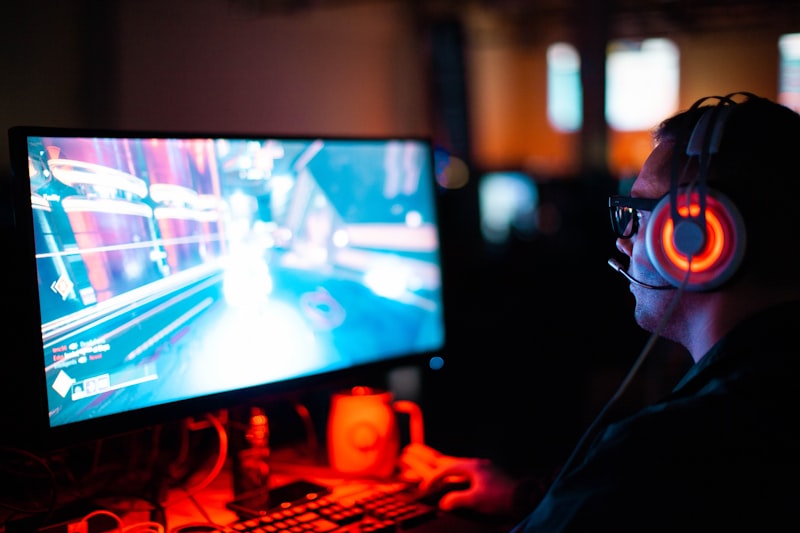The Importance of Graphics in Games: How Do We Optimize Visual Quality?


When it comes to gaming, one thing that instantly grabs our attention is the visual quality of a game. The graphics play a vital role in creating an immersive and captivating gaming experience. But have you ever wondered how game developers optimize the visual quality to make games look stunning?
Optimizing the graphics in games is a complex process that involves striking a balance between visual fidelity and performance. Game developers aim to create realistic and visually appealing environments while ensuring smooth gameplay for players. Achieving this delicate balance requires employing various techniques and technologies.
One key aspect of optimizing visual quality is the effective use of shaders. Shaders are small programs that control how light and shadows interact with objects in a game. They allow developers to simulate realistic lighting conditions and create stunning visual effects. By utilizing shaders effectively, game developers can enhance the overall graphical quality of a game.
Another crucial factor in optimizing visual quality is texture mapping. Textures add detail and depth to the surfaces of objects in a game. High-resolution textures can make the game world feel more lifelike and immersive. However, using excessively large textures can impact performance. Game developers employ advanced compression techniques to reduce the memory footprint of textures without compromising on quality, thus optimizing the visual experience.
Furthermore, the use of advanced rendering techniques such as real-time global illumination and dynamic shadows significantly contributes to the visual appeal of games. These techniques simulate the behavior of light in a realistic manner, resulting in more vibrant and believable virtual worlds.

In addition to technical considerations, artistic choices also play a significant role in optimizing visual quality. Skilled artists meticulously design and create visually striking assets, including character models, landscapes, and special effects. Their attention to detail and creative vision elevate the overall graphics of a game, making it visually captivating.
Overall, optimizing the visual quality of games is a multifaceted process that combines technical expertise and artistic creativity. By leveraging advanced technologies, employing effective shaders and textures, and making thoughtful artistic choices, game developers can create visually stunning games that leave players in awe.
So, the next time you find yourself marveling at the breathtaking graphics of a game, remember the intricate optimization process that goes behind creating such a visually captivating experience.
Unleashing the Power of Pixels: Exploring the Crucial Role of Graphics in Game Development

Are you ready to dive into the exciting world of game development? Prepare to be amazed as we unleash the power of pixels and explore the crucial role of graphics in creating captivating gaming experiences. Graphics play a pivotal role in bringing virtual worlds to life, captivating players and immersing them in rich and visually stunning environments.
When it comes to game development, graphics are like the brushstrokes on a canvas, painting a vivid picture for players to explore. Every pixel is carefully crafted to ignite the imagination and evoke emotions. From breathtaking landscapes to intricately designed characters, graphics have the ability to captivate players from the very first moment they enter a game.
But why are graphics so important in game development? Well, think about it this way: imagine playing a game with outdated and pixelated visuals versus one with realistic and high-definition graphics. Which one would capture your attention more? The answer is quite clear. High-quality graphics not only enhance the overall aesthetic appeal of a game but also contribute to the gameplay experience itself.
Graphics can create a sense of realism, making players feel like they are part of the game’s world. Whether it’s the subtle movement of leaves in the wind or the reflection of light on a shimmering lake, attention to detail in graphics adds depth and authenticity to the gaming experience. It’s these immersive qualities that keep players engaged and coming back for more.
Moreover, graphics have the power to convey information. Visual cues and indicators can guide players through complex levels, provide crucial feedback on their actions, and enhance the overall user interface. Imagine playing a puzzle game without visual hints or an action-packed adventure without clear visual prompts. Graphics serve as a language that speaks directly to the player, allowing them to navigate the game world effortlessly.
Graphics are the backbone of game development, unleashing the full potential of virtual worlds. They transport players to fantastical realms, engage their senses, and invite them on unforgettable journeys. So, whether you’re a player looking for an immersive experience or a developer aiming to create the next gaming masterpiece, never underestimate the power of pixels in shaping the world of games.
From Pixels to Perfection: Unraveling the Art and Science of Optimizing Visual Quality in Games

Have you ever wondered why some video games look incredibly stunning while others fall short in terms of visual quality? Well, it all comes down to the art and science of optimizing visual perfection in games. In this article, we will delve into the intricate details of how game developers transform mere pixels into breathtaking gaming experiences.
When it comes to creating visually appealing games, developers face the challenge of balancing aesthetics with performance. Every frame rendered on your screen is composed of countless pixels, and optimizing those pixels is crucial to achieving a visually immersive experience. From character models and textures to lighting and special effects, each element plays a vital role in crafting a visually striking game.
To optimize visual quality, developers employ cutting-edge techniques that push the boundaries of technology. High-resolution textures add intricacy to objects, making them appear more realistic and detailed. Advanced lighting models simulate real-world lighting conditions, casting dynamic shadows and reflections that enhance the overall visual fidelity. Moreover, post-processing effects such as motion blur, depth of field, and ambient occlusion add depth and realism to the game’s visuals.
But it’s not just about the technical aspects; artistic vision also plays a significant role in optimizing visual quality. Skilled artists meticulously design captivating worlds, compelling characters, and breathtaking landscapes that transport players into immersive virtual realms. They use their creativity to paint vivid scenes that evoke emotions and draw players deeper into the gaming experience.
Optimizing visual quality is a constant pursuit of perfection. Game developers continuously strive to harness the power of evolving hardware, leveraging new technologies to achieve greater graphical fidelity. This relentless drive to push the boundaries ensures that gamers are treated to visually stunning experiences that are more lifelike and awe-inspiring than ever before.
The art and science of optimizing visual quality in games is a delicate dance between technical prowess and artistic vision. Game developers meticulously fine-tune every pixel to create visually stunning and immersive experiences for players to enjoy. By combining cutting-edge technologies with creative artwork, the industry continues to raise the bar, transforming pixels into perfection, and delivering unforgettable gaming experiences.
Enhancing Immersion and Realism: The Key to Captivating Game Graphics
When it comes to captivating game graphics, enhancing immersion and realism is the key. Imagine stepping into a virtual world where every detail feels so lifelike that you can almost touch it. That’s the power of immersive graphics in gaming, and it’s what keeps players coming back for more.
One crucial aspect of creating immersive game graphics is attention to detail. Game developers strive to replicate real-world elements meticulously, from the way light interacts with objects to the subtle movements and expressions of characters. By paying close attention to these details, games can create a sense of authenticity that draws players deeper into the virtual experience.
Another technique used to enhance immersion is the use of advanced rendering technologies. With the continuous advancements in hardware and software, game developers now have access to powerful tools that can deliver stunning visuals. Real-time ray tracing, for example, allows for realistic lighting and reflections, bringing virtual environments to life like never before. This technology enables games to achieve an unprecedented level of visual fidelity, making them visually breathtaking and believable.
Furthermore, sound design plays a crucial role in creating an immersive gaming experience. High-quality audio effects and spatial sound can transport players into the game world, adding depth and realism. Imagine hearing the rustling leaves in a dense forest or the echoing footsteps in an abandoned hallway. These audio cues not only enhance the overall immersion but also contribute to the emotional impact of the game.
To achieve captivating game graphics, developers must also consider the performance aspect. Optimizing graphics settings and utilizing efficient rendering techniques ensure smooth gameplay without sacrificing visual quality. Striking the right balance between performance and realism is essential to provide an enjoyable gaming experience on various platforms.
Enhancing immersion and realism is the key to captivating game graphics. By paying attention to detail, utilizing advanced rendering technologies, incorporating immersive sound design, and optimizing performance, game developers can create visually stunning worlds that captivate players and keep them engaged for hours on end. So, gear up and get ready to dive into a virtual universe where reality meets imagination. The adventure awaits!
Visual Feast or Performance Nightmare? Striking the Balance between Stunning Graphics and Smooth Gameplay
Are you a gaming enthusiast who craves visually stunning graphics and seamless gameplay? If so, you’ve probably encountered the eternal struggle of balancing impressive visuals with smooth performance. In the realm of gaming, finding the sweet spot between a visual feast and a performance nightmare is crucial for an immersive experience.
Picture this: you’re embarking on an epic adventure in a virtual world, mesmerized by breathtaking landscapes and intricate details. Each pixel seems to come alive, creating an awe-inspiring visual spectacle. But suddenly, your excitement wanes as frame rates drop, causing lag and disrupting your gameplay flow. The frustration sets in, leaving you torn between the desire for jaw-dropping graphics and the need for fluid gameplay.

Striking the perfect balance requires game developers to navigate a delicate tightrope. On one hand, they must harness cutting-edge technology to deliver realistic environments, lifelike characters, and mind-blowing special effects. These eye-catching elements captivate players, immersing them in a visual wonderland. On the other hand, performance optimization is vital to ensure that games run smoothly across various platforms and hardware configurations.
Game developers employ ingenious techniques like dynamic resolution scaling, adaptive graphics settings, and efficient resource management to maintain a consistent frame rate without compromising visual quality. They strive to avoid scenarios where you’re torn between sacrificing graphical fidelity for smoother gameplay or vice versa.
Think of it this way: imagine you’re savoring a sumptuous meal at a high-end restaurant. The presentation is exquisite; each dish is a work of art. But what if the taste doesn’t live up to the visual splendor? That culinary masterpiece would lose its charm. Similarly, in gaming, exceptional visuals may initially astound you, but if the gameplay suffers, the overall experience falls short.
So, how can game developers strike the perfect balance? It requires meticulous optimization, rigorous testing, and an understanding that player satisfaction lies at the core. By prioritizing both stunning graphics and smooth gameplay, developers can create a harmonious synergy that enhances immersion while keeping frustrations at bay.
Finding equilibrium between breathtaking visuals and flawless performance is an ongoing quest in the gaming industry. Game developers continuously strive to push the boundaries of graphical fidelity while ensuring smooth gameplay for an unforgettable experience. The pursuit of this balance guarantees that you, as a player, can feast your eyes on stunning visuals without sacrificing the joy of seamless gaming.




